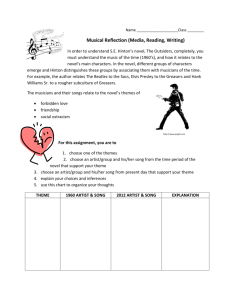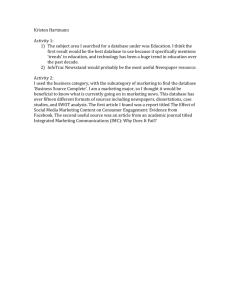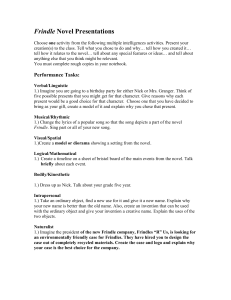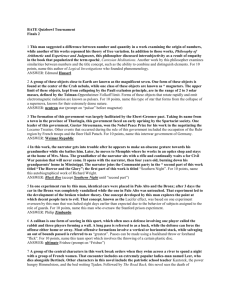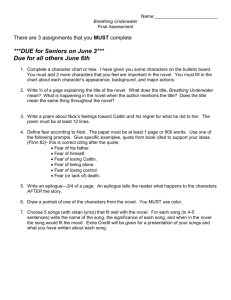Round 4 - High School Quizbowl Packet Archive
advertisement
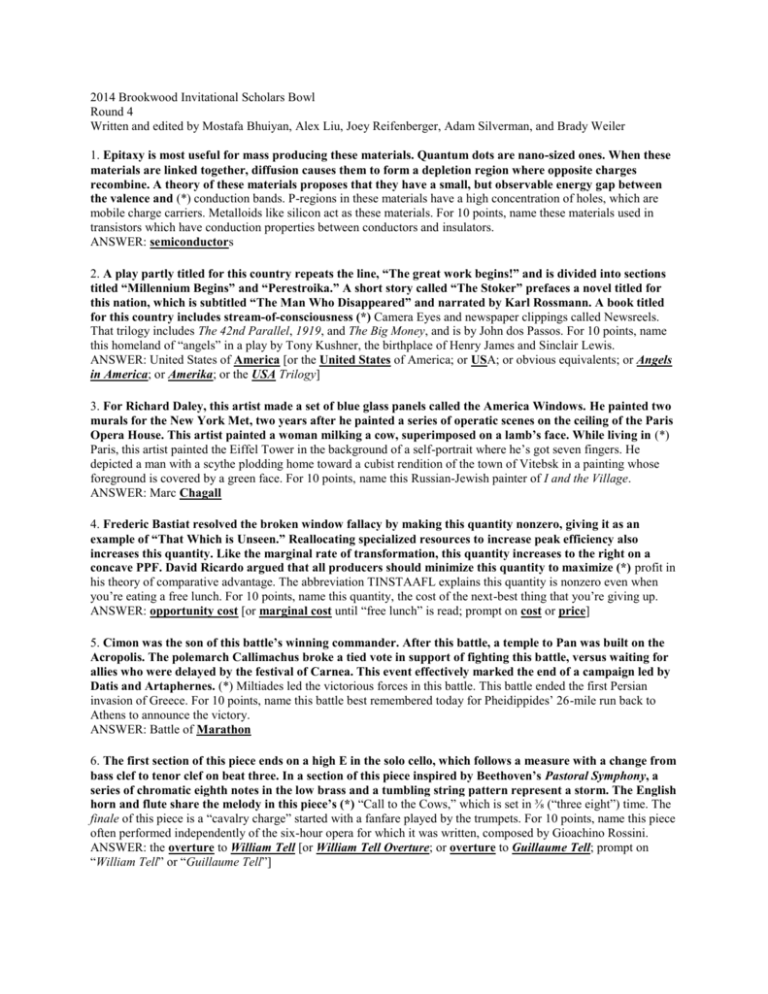
2014 Brookwood Invitational Scholars Bowl Round 4 Written and edited by Mostafa Bhuiyan, Alex Liu, Joey Reifenberger, Adam Silverman, and Brady Weiler 1. Epitaxy is most useful for mass producing these materials. Quantum dots are nano-sized ones. When these materials are linked together, diffusion causes them to form a depletion region where opposite charges recombine. A theory of these materials proposes that they have a small, but observable energy gap between the valence and (*) conduction bands. P-regions in these materials have a high concentration of holes, which are mobile charge carriers. Metalloids like silicon act as these materials. For 10 points, name these materials used in transistors which have conduction properties between conductors and insulators. ANSWER: semiconductors 2. A play partly titled for this country repeats the line, “The great work begins!” and is divided into sections titled “Millennium Begins” and “Perestroika.” A short story called “The Stoker” prefaces a novel titled for this nation, which is subtitled “The Man Who Disappeared” and narrated by Karl Rossmann. A book titled for this country includes stream-of-consciousness (*) Camera Eyes and newspaper clippings called Newsreels. That trilogy includes The 42nd Parallel, 1919, and The Big Money, and is by John dos Passos. For 10 points, name this homeland of “angels” in a play by Tony Kushner, the birthplace of Henry James and Sinclair Lewis. ANSWER: United States of America [or the United States of America; or USA; or obvious equivalents; or Angels in America; or Amerika; or the USA Trilogy] 3. For Richard Daley, this artist made a set of blue glass panels called the America Windows. He painted two murals for the New York Met, two years after he painted a series of operatic scenes on the ceiling of the Paris Opera House. This artist painted a woman milking a cow, superimposed on a lamb’s face. While living in (*) Paris, this artist painted the Eiffel Tower in the background of a self-portrait where he’s got seven fingers. He depicted a man with a scythe plodding home toward a cubist rendition of the town of Vitebsk in a painting whose foreground is covered by a green face. For 10 points, name this Russian-Jewish painter of I and the Village. ANSWER: Marc Chagall 4. Frederic Bastiat resolved the broken window fallacy by making this quantity nonzero, giving it as an example of “That Which is Unseen.” Reallocating specialized resources to increase peak efficiency also increases this quantity. Like the marginal rate of transformation, this quantity increases to the right on a concave PPF. David Ricardo argued that all producers should minimize this quantity to maximize (*) profit in his theory of comparative advantage. The abbreviation TINSTAAFL explains this quantity is nonzero even when you’re eating a free lunch. For 10 points, name this quantity, the cost of the next-best thing that you’re giving up. ANSWER: opportunity cost [or marginal cost until “free lunch” is read; prompt on cost or price] 5. Cimon was the son of this battle’s winning commander. After this battle, a temple to Pan was built on the Acropolis. The polemarch Callimachus broke a tied vote in support of fighting this battle, versus waiting for allies who were delayed by the festival of Carnea. This event effectively marked the end of a campaign led by Datis and Artaphernes. (*) Miltiades led the victorious forces in this battle. This battle ended the first Persian invasion of Greece. For 10 points, name this battle best remembered today for Pheidippides’ 26-mile run back to Athens to announce the victory. ANSWER: Battle of Marathon 6. The first section of this piece ends on a high E in the solo cello, which follows a measure with a change from bass clef to tenor clef on beat three. In a section of this piece inspired by Beethoven’s Pastoral Symphony, a series of chromatic eighth notes in the low brass and a tumbling string pattern represent a storm. The English horn and flute share the melody in this piece’s (*) “Call to the Cows,” which is set in ⅜ (“three eight”) time. The finale of this piece is a “cavalry charge” started with a fanfare played by the trumpets. For 10 points, name this piece often performed independently of the six-hour opera for which it was written, composed by Gioachino Rossini. ANSWER: the overture to William Tell [or William Tell Overture; or overture to Guillaume Tell; prompt on “William Tell” or “Guillaume Tell”] 7. Mador accuses this character of poisoning Patrise. Infuriated by the sight of a red sleeve embroidered with pearls, this person secretly gives away a sleeve made out of gold. Melegeant abducts this character in an early work by Chretien de Troyes. This character is saved from being burned at the stake three separate times, but then gets locked up in the (*) Tower of London and eventually dies in a convent. Elaine disguises herself as this daughter of Leodegrance. Mordred eventually abducts this woman once her affair with Launcelot is revealed. For 10 points, name this queen of King Arthur. ANSWER: Queen Guinevere Moderator note: “antiports” is a verb, similar to “transports”. Also, cation is pronounced “CAT-EYE-ON”. 8. NHE-1 antiports protons and ions of this element. This element enters the cell through a selectivity filter in Hodgkin-Huxley channels. CFTR, which is defective in CF patients, transports this cation. Hyperpolarization is caused by a massive influx of this element during action potentials; normally, its concentration is much higher in the extracellular fluid. Osmoregulation by the kidneys controls the level of this element relative to (*) water. In the classic example of active transport, three atoms of this element are pumped against two atoms of potassium. For 10 points, name this element excreted as sweat. ANSWER: sodium [or Na+] 9. At this man’s wedding, a jokester tells a story about women who get turned into birds, then pygmies, for laughing at Osseo. While fasting for seven days and nights, this character kills Mondamin in a wrestling contest. This character wins an epic battle against a sturgeon, and, in another contest, slays a man who’s only vulnerable on a single (*) feather. Kwasind and Chibiabos are this character’s best friends. This grandson of Nokomis marries Minnehaha, and lives “by the shores of Gitchee-Gumee, by the Shining Big-Sea Water”. For 10 points, name this Native American hero memorialized in a “song” by Longfellow. ANSWER: Hiawatha [or The Song of Hiawatha] 10. This man responded to praise from Moses Seixas in his “Letter to the Hebrew Congregation at Newport.” This man said that “overgrown military establishments” are hostile to liberty in a speech explaining that North and South, and East and West, were in “unrestrained intercourse.” This man shamed rebellious officers in his Newburgh Address. This man warned (*) America against meddling in foreign affairs and dividing into factions in his Farewell Address. In a eulogy, Henry Lee called him, “first in war, first in peace, and first in the hearts of his countrymen.” For 10 points, name this first US president. ANSWER: George Washington 11. A leader during this war blamed the rebellion on hallucinogens mixed into rebels’ Nescafé. Abdul Fatah Younis was likely murdered by the National Transitional Council during this conflict. It ended with fighting near Sirte. The National Liberation Army relieved a siege at Misrata during this war. As part of Operation (*) Odyssey Dawn, the US fired 110 Tomahawk missiles to guard a no-fly zone established during this war. A red, black, and green-striped flag replaced a plain green flag, following this war. For 10 points, name this revolution during Arab Spring which ousted Muammar Gaddafi’s government from Tripoli. ANSWER: 2011 Libyan Civil War [or the Libyan Revolution; or equivalents that mention a revolution which took place in Libya] 12. This adjective describes “bodies” which have emissivity independent of wavelength. During embryonic development, the side of the zygote opposite the site of fertilization is a crescent described by this adjective. This color shares its name with the SI unit of absorbed radiative dose. This color corresponds to pixels which have (*) equal R, G, and B values between 1 and 254. An Englishman with this last name wrote a classic 1858 text on anatomy. For 10 points, name this adjective which describes nonmyelinated “matter” in the brain, a color formed from mixing black and white. ANSWER: gray [or grey] 13. Samuel Putnam and John Ormsby translated this book. The second part of this novel mocks a fake sequel to the first part. This novel, which famously opens by describing a town “whose name I do not wish to recall”, is allegedly based on a manuscript by Cide Hamete Benengeli. The author of this book drew on his experience being captured by (*) pirates to write a scene where the protagonist frees some galley slaves. Amadis of Gaul and other books of chivalry are torched by concerned citizens of La Mancha in this novel. For 10 points, name this book in which an errant knight charges at windmills, written by Miguel de Cervantes. ANSWER: Don Quixote [or Don Quijote] 14. Fabriano, Italy was a center for the production of this commodity. Harun-al-Rashid’s son Ja’far began the manufacture of this commodity in Samarkand with the help of two prisoners captured at the Battle of Talas. Amate was analogous to this commodity in the New World. Don-cho traded this commodity to Japan. It was used as (*) currency in the Song dynasty. A eunuch named Cai Lun used hemp and mulberry bark to manufacture this commodity. It was grouped with the compass, gunpowder, and printing as the Four Great Inventions of China. For 10 points, name this material analogous to Egyptian papyrus, used for writing. ANSWER: paper [or paper currency] 15. Muddy Waters sang that, “I was a catfish, swimmin’ in an oh deep blue sea” in a song titled for one of these objects. A song titled for these objects mentions that “Wherever he laid his hat was his home”; that 1971 hit for The Temptations mentions that Papa was one of these things. Another song’s chorus asks “How does it feel?” before comparing (*) “being on your own” and “like a complete unknown” to being like one of these objects. A band titled for these objects used a Keith Richards guitar riff in their song “(I Can’t Get No) Satisfaction.” For 10 points, name these objects which name a popular music magazine as well as a band headed by Mick Jagger. ANSWER: rolling stones [or The Rolling Stones; or “Like a Rolling Stone; or “Papa Was a Rolling Stone”; or “Rollin’ Stone”; or Rolling Stone Magazine; prompt on partial answer] 16. A performance artist from this country covered his face in honey and tried to explain some paintings to a dead hare. Today, the Market-Gate of Miletus is in this country, in a museum filled with Pergamon artifacts. A huge Gothic cathedral in this nation begun in 1248 was finally completed in 1880. Norman Foster added a glass dome to this nation’s capitol, which was wrapped by (*) Christo in 1995. An architect from this country designed the Seagram Building in New York City and used the mantra, “Less is more.” Walter Gropius founded the Bauhaus in this nation. For 10 points, name this birthplace of Mies van der Rohe, the site of the Brandenburg Gate. ANSWER: Federal Republic of Germany [or Deutschland] 17. According to Hund’s first rule, a quantity symbolized by this letter should be maximized when placing electrons in orbitals. This letter describes a stereocenter where the groups are arranged counterclockwise in priority. The epitaph on Boltzmann’s tombstone reads “<this letter> equals k log W”. A physical quantity symbolized by this letter is quantized by one-half h-bar for electrons. This (*) block on the Periodic Table contains the alkali and alkaline earth metals. This letter symbolizes entropy. For 10 points, name this letter which is the atomic symbol of a yellow, smelly element with atomic number 16. ANSWER: S [or s] 18. During WWI, this person was imprisoned at the Amherst Internment Camp in Halifax, Nova Scotia. The Declaration of the 46 agreed with this person’s views. This man theorized that nations underwent “uneven and combined development”, and therefore didn’t need to pass through multiple stages, in his theory of permanent revolution. As (*) Commissar of Foreign Affairs, this politician signed the Treaty of Brest-Litovsk and rebranded the Red Army with ex-tsarist generals. Ramon Mercader ice-picked this man to death in Mexico City in 1940. For 10 points, name this man who never learned why you don’t argue with Josef Stalin. ANSWER: Leon Trotsky 19. This book uses the analogy of a statue with purple eyes to explain why one person’s pleasure is subservient to the common good. At the end of this work, an “everyman” narrates the journey of dead souls to the spindle of Necessity. This book contrasts the real world to a world of ideal universals by likening the Sun to the Form of the Good. It opens by asking for a definition of (*) justice. This book describes the Ship of State, which can only be captained by philosopher-kings. It also describes prisoners chained to a wall who only see shadows, in its Allegory of the Cave. For 10 points, name this Platonic dialogue about an ideal city-state. ANSWER: The Republic [or Politeia] 20. A character created by this author begs to go on a chair ride, so he can “hug the walls” separating him from the “other hell”, before being placed back down in the exact center of the room. In a play by this author, a character sings about a dog who steals a piece of bread and wonders about the two thieves at Jesus’ crucifixion. In that play by this author, a slave on a (*) leash sings and dances in Act I, though his master goes blind by Act II. This author wrote about Ham and Clov in Endgame, and in another play, gave, “They do not move” as the final stage instruction to Vladimir and Estragon. For 10 points, name this Irish author of Waiting for Godot. ANSWER: Samuel Beckett TB: Euler proved that the sum of the reciprocal of these numbers is asymptotic to the log of the log of a limiting n. The quadratic function “x squared plus x plus 41” has these numbers as its range, if the domain is integers less than 40. Euclid explained that the product of a set of numbers with this property, plus one, also has this (*) property. Every even number can be written as the sum of two of them according to Goldbach’s conjecture. Every integer can be written into a unique product of them by the Fundamental Theorem of Arithmetic. For 10 points, name these numbers which which have only two factors: themselves, and 1. ANSWER: prime numbers [or primality] 1. A massive cholera epidemic broke out in this island nation soon after a 2010 earthquake devastated its inhabitants. For 10 points each: [10] Name this Caribbean island country, the poorest in the Western Hemisphere, which shares Hispaniola with the Dominican Republic. ANSWER: Republic of Haiti [10] In 1998, things weren’t much better for Latin America when this hurricane devastated the region and killed eighteen thousand people. It’s the second-deadliest hurricane of all time, after an 1870 storm. ANSWER: Hurricane Mitch [10] Mitch was brutal to this Central American country, which had just ended its 1960-1996 civil war. Rigoberta Menchu campaigned for the rights of ethnic Mayans in this country directly south of Mexico. ANSWER: Republic of Guatemala 2. This man often collaborated with both Gil Evans and Bill Evans, the latter of whom played piano on his most famous album. For 10 points each: [10] Name this jazz trumpeter, the artist behind Nefertiti and Kind of Blue. ANSWER: Miles Davis [10] A non-Kind of Blue 1959 Davis album is comprised of jazz arrangements of an opera by this composer. This man wrote the jazz standards “Embraceable You” and “I Got Rhythm” with his brother Ira. ANSWER: George Gershwin [that Davis album is Porgy and Bess] [10] Davis’ album In a Silent Way was a seminal album in the genre of jazz fusion, the style of this jazz group. This band led by Wayne Shorter performed the song “Birdland,” written by its keyboardist Joe Zawinul. ANSWER: Weather Report 3. This author had a minor role in the film adaptation of his anti-war novel A Time to Love and a Time to Die. For 10 points each: [10] Name this author of The Road Back, who, in his best-known novel, created the character of Paul Baumer, a disenchanted German soldier in World War I. ANSWER: Erich Marie Remarque [10] Baumer eventually dies at the end of this propagandist novel by Remarque. The Nazis really liked burning this book. ANSWER: All Quiet on the Western Front [or Im Westen nichts Neues] [10] This English poet mocked WWI in his poem “Victory Ball.” He wrote about a character seeking the hand of “Bess, the landlord’s daughter” in his frequently-anthologized poem “The Highwayman.” ANSWER: Alfred Noyes 4. Answer the following about things that can cause cancer, for 10 points each: [10] This term refers to anything that can cause cancer, often by mutating DNA to allow for unlimited cell division. The Ames test is used to distinguish these agents. ANSWER: carcinogen [or word forms] [10] The human papillomavirus is the major cause of this type of cancer, which is detected using a Pap smear. ANSWER: cervical cancer [10] Many cancers are linked to mutations not in coding sequences, but in these changes, which affect how much a gene is expressed. Histone methylation and acetylation follow this type of mechanism. ANSWER: epigenetics [or word forms] 5. Though it is not Iran, the Tehran Eight fought for this country in the 1980s. For 10 points each: [10] Name this country which the Soviet Union invaded in 1979. ANSWER: Democratic Republic of Afghanistan [10] This man provided money to the mujahideen to resist the Soviet invasion; later, in 1988, he founded al-Qaeda. ANSWER: Osama bin Laden [or Osama bin Laden; or Usama bin Laden] [10] Veteran mujahideen also assisted Muslim rebels in this region during a 1999 war prompted by the invasion of Dagestan. A group of Islamic militants occupied a school in Beslan, in this region, in 2004. ANSWER: Chechnya [or the Chechen Republic; or Ichkeria] 6. Name some authors of tales, for 10 points each: [10] This author included some truly vulgar stories in his collection of 20-odd tales told by pilgrims visiting Thomas a Becket’s shrine in Canterbury. ANSWER: Geoffrey Chaucer [10] Chaucer was likely influenced by this medieval Italian author, whose best-known collection consists of 100 stories: ten stories told by each of ten people over ten days. ANSWER: Giovanni Boccaccio [10] This English polymath compiled the Arabian Nights into The Book of the Thousand Nights and a Night. He also translated the Kama Sutra and voyaged to discover the source of the Nile with John Hanning Speke. ANSWER: Richard Francis Burton 7. Two sets of this instrument duel in the last movement of Carl Nielsen’s Inextinguishable Symphony. For 10 points each: [10] Name this percussion instrument consisting of four drums that are tuned by a pedal attached to the bottom. This instrument usually played with mallets often has to be muffled or dampened immediately after being struck. ANSWER: timpani [or kettledrums] [10] While serving as the timpanist for this orchestra, William Kraft composed and premiered his timpani concerto. This orchestra once led by Zubin Mehta and André Previn plays its concerts at Walt Disney Concert Hall. ANSWER: Los Angeles Philharmonic [or LA Phil] [10] In an unusual compositional choice, this composer calls for maracas to be used to strike the timpani in his Jeremiah Symphony. Other works by this composer include the ballet Fancy Free and the operetta Candide. ANSWER: Leonard Bernstein 8. In the senatorial address “In Verrum,” Cicero declared that he possessed this status. For 10 points each: [10] Name this priviliged status which allowed men to vote while preventing them from being executed. When slaves earned this status, they became known as liberti. ANSWER: Roman citizenship [the Cicero quote is “civus Romanus sum.”] [10] After slaves earned Roman citizenship they often acquired this other social status, in which they were sponsored or favored in some way by the former master, who was known as the patron. ANSWER: clients [or word forms; or the patron-client system] [10] Patrons and clients would have a daily morning greeting to renew their relationship called the salutatio, which often took place in the tablinum of this building which also had a triclinium and a lararium. ANSWER: Roman domus [or Roman household] 9. A woman named for one a “white” example of these animals taught the Lakotas seven rituals and brought them the pipe, and was eventually syncretized with Mary. For 10 points each: [10] Name these animals which were originally corraled by Humpback until they were scared by a dog barking in the pen and escaped. They provided sustenance to many Native American tribes. ANSWER: buffalo [or bison] [10] This character, the prototypical trickster in Native American culture, let the buffalo out by barking like a dog. His duties are often shared by Raven. ANSWER: Coyote [10] In Navajo myth, Coyote created this object by throwing a bag up into the air. In China, this object is the river that separates Zhinu and Niulang, and is bridged once a year by magpies. ANSWER: the Milky Way 10. The “multiple” form of this process determines a model for how a set of linearly independent variables impact a response variable. For 10 points each: [10] Name this process which often involves curve-fitting to approximate the relationship between two sets of data. The ordinary least-squares form of this process can be used to calculate a line of best fit. ANSWER: linear regression analysis [or word forms] [10] The goal of regression is to maximize this quantity. If this quantity, which is sometimes named for Pearson, equals one, then the regression is a perfect fit for the data. ANSWER: R squared [or Pearson’s r; or the coefficient of determination; or correlation coefficient] [10] OLS regression minimizes the residuals, not this quantity, which is the difference between the true value and the observed value in the experiment. The “margin” of this quantity is one over the square root of sample size. ANSWER: statistical error [or margin of error] 11. This man’s administration passed the Walker Tariff, which was named for this man’s Treasury Secretary. For 10 points each: [10] Name this expansionist president who oversaw the acquisition of the Oregon Territory and the Republic of Texas during his one term. Under this president’s leadership, America was victorious in the Mexican War. ANSWER: James K. Polk [10] Polk chose Nicholas Trist to negotiate this treaty which ended the Mexican-American War. This treaty ceded California to the US and made the Rio Grande a national boundary. ANSWER: Treaty of Guadalupe Hidalgo [or Tratado de Guadalupe Hidalgo; or the Treaty of Peace, Friendship, Limits and Settlement between the United States of America and the Mexican Republic] [10] Ratification of the Treaty of Guadalupe Hidalgo in Congress was delayed by an effort to attach this measure. Named for its Pennsylvania author, it called for slavery to be banned in any territory gained from Mexico. ANSWER: Wilmot Proviso 12. Yellow pigments in this painting have gradually darkened over time into an ugly brown color because the zinc chromate pigment used has faded into ochre. For 10 points each: [10] Name this 1884 painting which now hangs at the Art Institute of Chicago. The only person in this painting “looking” directly at the viewer is a small girl in a white dress and hat; nearly everyone else is “looking” to the left. ANSWER: A Sunday Afternoon on the Island of La Grande Jatte [or Un dimanche apres-midi] [10] A Sunday Afternoon was painted in this artist’s trademark pointillist style. He also made Bathers at Asnieres. ANSWER: Georges Seurat [10] The painting’s main focus appears to be a woman standing with her husband in the right foreground. The woman holds two objects: Name either. ANSWER: a leash with a monkey OR an umbrella [or a monkey; or a parasol] 13. Answer the following about Hasidic Judaism, for 10 points each: [10] Hasidism is a branch of this school of Judaism. This school follows traditions more strictly than do either Conservative or Reform Judaism. ANSWER: Orthodox Judaism [or word forms] [10] In this novel by Chaim Potok, Danny is a Hasid but his friend Reuben is not. It was followed up by a sequel titled The Promise. ANSWER: The Chosen [10] This Orthodox Jew, though not a Hasid, served in the Senate for much of the 2000s before his 2013 resignation. He caucused with the Democrats, but supported John McCain in the 2008 election. ANSWER: Joseph Isadore “Joe” Lieberman [do not accept or prompt on “Joe Biden”] 14. This effect causes spectral lines to broaden because of a non-uniform velocity distribution. For 10 points each: [10] Name this effect which causes a “shift” equal to velocity plus receiver velocity over velocity plus source velocity. ANSWER: Doppler effect [10] The Doppler effect causes a redshift of light received from distant galaxies, which is evidence that the universe is undergoing this process. This process happened rapidly during cosmic inflation right after the Big Bang. ANSWER: expansion [or same-knowledge equivalents such as the universe is getting bigger] [10] Relativistically, the Doppler shift also includes this term, which is one for non-relativistic motion. This quantity equals the ratio between proper time and observed time, and the ratio of actual length over contracted length. ANSWER: Lorentz factor [or gamma] 15. This character dresses up as a gypsy woman in order to tell his fiancee that he’s not really that wealthy. For 10 points each: [10] Name this old friend of Mr. Mason, the owner of Thornfield Hall. He employs Grace Poole to look over his deranged wife. ANSWER: Mr. Edward Rochester [10] Rochester ends up marrying this ex-governess at the end of the novel, after this character realizes that going to India and proselytizing doesn’t sound like her cup of tea. ANSWER: Jane Eyre [or Jane Eyre] [10] This sister of authors Emily and Anne wrote Jane Eyre. ANSWER: Charlotte Brönte [prompt on partial answer] 16. Taoiseach [pr. TEA-SHICH] Brian Cowen, the prime minister of this nation, was incriminated in 2009 after revelations that this country’s central bank had hidden millions of euros worth of loans. For 10 points each: [10] Name this country which was partitioned in two in 1920, then declared a “Free State” two years later. ANSWER: Republic of Ireland [10] Long ago are the days when Ireland was known as the “Celtic” one of these animals. These animals are frequently used to refer to Hong Kong, Singapore, Taiwan, and South Korea for their rapid economic growth. ANSWER: tigers [or the Four Asian Tigers] [10] Political conflicts between Ireland and England in Northern Ireland in recent years largely originate because the majority of Irish follow this denomination of Christianity. ANSWER: Roman Catholicism 17. Answer the following about American culture wars, for 10 points each: [10] On the abortion front, the culture war is contested between people who are “pro-life” and these opponents, who oppose criminalization of abortion. ANSWER: pro-choicers [10] This pundit wrote the book Culture Warrior, which he defined as an opponent of secular-progressivism. This conservative has also written bestsellers like Killing Lincoln and hosts a show with a “no-spin zone.” ANSWER: Bill O’Reilly [10] In February 2014, this man debated Ken Ham on the question “Is Creation a Viable Model of Origins?” at the Creation Museum in Kentucky. He sided with the evolutionists. ANSWER: William Sanford “Bill” Nye [or Bill Nye the Science Guy] 18. Canon 9 of the Council of Trent declared that people who observe this doctrine would be anathema. For 10 points each: [10] Name this Protestant doctrine which argues that only one single thing could be used as a determining factor for people who receive God’s grace. It was called the “doctrine by which the Church stands or falls.” ANSWER: sola fide [or justification by faith alone] [10] Sola fide completely ignores the impact of these things, the good actions and deeds done by a person to try and achieve salvation. ANSWER: good works [10] Sola fide was vital to the ideas of this German former monk who kicked off the Protestant Reformation in 1517 by nailing his Ninety-Five Theses to the door of a church. ANSWER: Martin Luther 19. Yunioshi improbably finds a carving of this woman while travelling around Africa. For 10 points each: [10] Name this literary character who complains about the “mean reds” and calls the narrator Fred for no real reason. She delivers “weather reports” to gangster Sally Tomato. ANSWER: Holly Golightly [or Holly Golightly] [10] Socialite Holly Golightly appears in this novella. ANSWER: Breakfast at Tiffany’s [10] This author wrote Breakfast at Tiffany’s as well as a “nonfiction novel” titled In Cold Blood. ANSWER: Truman Capote 20. The basis of valence shell electron pair repulsion theory is that atoms are stablest when they’ve got this many valence electrons. For 10 points each: [10] Give this number of electrons in the valence shell of noble gases and ions that follow the octet rule. ANSWER: eight [10] VSEPR theory predicts this molecular geometry for a covalent compound which has five bonded substituents and no lone pairs; a common example is phosphorus pentachloride, which isn’t a fan of the whole octet rule thing. ANSWER: trigonal bipyramidal [10] Though the bond angle between axial and equatorial substituents in trigonal bipyramidal compounds is 90 degrees, it’s this angle measure between equatorial groups. This is the bond angle of trigonal planar compounds. ANSWER: 120 degrees
